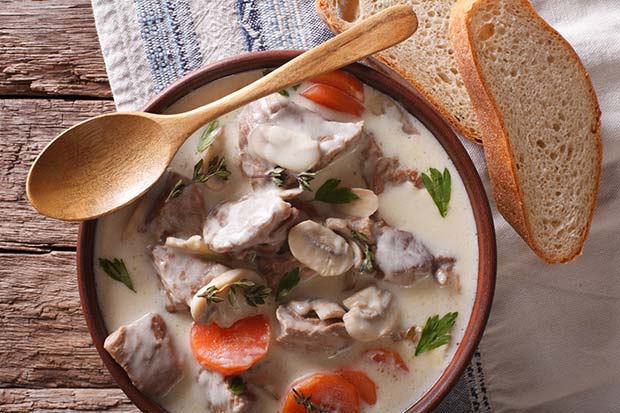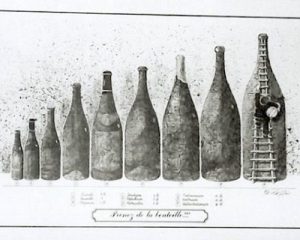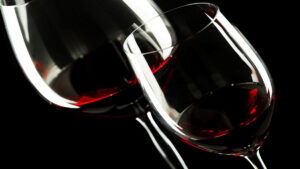
Today we’re taking a look at wine pairings for hearty and mouth- watering slow cooked dishes – often French classics. Whether you’re looking for inspiration for your next Sunday dinner or for a delicious meal after work, we have you covered! These wholesome, slow-cooked recipes are a delight to eat in cold weather; some of these are traditional, but we also stray further afield too.
Braised beef (paleron) with carrots
A paleron is a French cut of beef with a gelatinous sinewy strip in the middle that melts during the cooking. First of all, brown the meat slowly in a casserole dish, then leave to cook in a lightly seasoned beef stock for four hours. Add sliced carrots an hour before the end. For the wine, bear in mind the extremely tender texture of the meat (and carrots) and the absence of fat. Red wines with a bit of body are best (we are talking about beef, after all) as long as the tannins aren’t obvious. Most of the time, everyday, fruity Cabernet Francs from the Loire are ideal, such as Saumur Champigny, Chinon, Bourgueil and Anjou. Avoid “high-end” reds that have been aged in oak barrels for a long period as they will be too tannic. If you can’t find a Loire wine you could try a Pinot Noir from the Alsace or Jura (once again choose a lighter, fruitier wine), a Mercurey or a red Mâcon.
Pork hotpot
There are as many recipes in France as there are regions but they all have the same basic ingredients: one or more cuts of lightly salted pork (shoulder or breast), one or several types of sausage, usually lightly smoked, cabbage, potatoes and/or carrots. Everything is cooked slowly for hours in a stock. The two guiding factors for wine choice are the fattiness of the meat and the smokiness of the sausages. Fruity wines with a crisp texture, reasonable acidity and subtle tannins are best. Most Beaujolais wines fit the bill, although perhaps not the denser wines you often find in Morgon and Moulin-à-Vent. Jura wines also come into their own with this dish, especially if made from the local Trousseau and Poulsard grape varieties. A red Mâcon or Mercurey would also be good.
Blanquette of veal (or poultry)
A classic of classics in France. Every recipe has its own take, but the basics remain the same. First, simmer mixed cuts of veal (tendrons, shoulder, etc) in stock for several hours. Then, add button mushrooms, pearl onions and a sauce made from stock, egg and cream with a dash of lemon. There are two points to consider when choosing wine for this dish – the cream and the tenderness of the veal cooked in stock. Red wines are out of the question. Of the whites, steer clear of wines with an “upfront” acidity (Muscadet, Riesling, Chenin) and go for something fuller. You could try a Mâcon or Pouilly Fuissé, Meursault, Chignin Bergeron, Arbois Chardonnay, Saint Joseph or Crozes Hermitage. The pairing is the same if you replace the veal with poultry (turkey more often than not).
Marengo (chicken or veal)
This dish is made with pieces of veal (shoulder generally) or a chicken cut into eight pieces. Start by colouring the meat in a casserole dish, then, deglaze the pan with white wine, add crushed tomatoes and leave to look cook slowly for several hours. The key factors here are the delicate quality of the meat and the marked flavour of the tomatoes. This dish goes well with both red and white wine. If you go for a white wine choose one that can withstand the tomato. This means a wine with some power to it but that isn’t overly aromatic, such as a Saint Joseph, Crozes Hermitage, Côtes du Rhône (Cairanne, Ventoux), Bandol, Bellet, or Patrimonio. If you prefer red, stay with Saint Joseph or Crozes Hermitage, or go for a less powerful Côtes du Rhône, a Côtes de Provence, or a fruity Languedoc. You might be interested to know that we would suggest the same wines for an Italian Osso Bucco.
Tagines
Because there are so many types of tagine, this dish can take very different directions in flavour and often combines sweet and savoury. The common point is that all dishes are generally spicy. Not necessarily piquant but definitely intensely flavoured. Let’s start with straightforward savoury tagines. The meat could be lamb, chicken or veal, but that isn’t the main point when it comes to wine accompaniments. What matters is the spicy aspect. Wines need to complement these prominent flavours and the best choice is often a robust red, preferably from the south. All the wines of the southern Rhône work well, from the best-known Châteauneuf du Pape to the surrounding appellations (Gigondas, Vacqueyras, Cairanne, Rasteau, Lirac) or the predominantly Grenache based wines. Close in spirit, the appellations of Languedoc and Roussillon also work very well as do many Côtes de Provence reds, especially if the Cabernet Sauvignon content is low.
Savoury tagines (veal and chicken-based) can also be paired with “strong” white wines with some body and low acidity. Keep south and choose white southern Rhône wines (Châteauneuf-du-Pape or any other appellation in the area), Languedoc whites (rather than Roussillon wines that can be a little too austere), or a wine from the Northern Rhône (especially Saint Joseph) with low acidity and a structure that complements the dish. Finally, a rosé wine with a high alcohol content can be a good choice in the summer. Go for a Tavel or one of the more powerful wines from Roussillon or Bandol. Tagines with sweet and sour flavours are best paired with semi-sweet wines from the Loire. (Vouvray and Montlouis) or Alsace, especially if made from Pinot Gris. Some of the more subtly sweet Jura wines would also go well and make for an unusual but rather magical combination!
Shop all wines on sale



